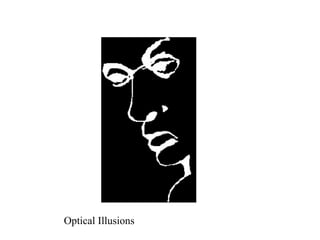
Vision and Optical Illusions
- 5. Click para otra ilusión óptica
- 13. Sight
- 14. THE AMAZING EYE !
- 15. Works somewhat like a camera. It takes in light for image to be “understood/seen”, It must be processed in the brain. Eyes are actually extensions of the brain
- 16. ANATOMY OF THE EYE The eye is round, like a ball or a balloon. It is made of many separate components and tunics (layers). Only 1/6 of the eye is exposed/visible (the rest is enclosed in fat and bone).
- 17. !
- 18. Diagram of the Eye (frontal view) sclera conjunctiva (membrane) medial canthus lateral canthus . . . . . iris pupil ciliary meibomium glands glands (oily) (lubricate eye)
- 19. Interior apparatus associated with the eye: lacrimal glands nasolacrimal duct Tears contain antibodies and lysozymes (enzymes that kill bacteria).
- 20. Six external eye muscles control eye movement: 4 rectus muscles (up, down, left and right) 2 oblique muscles Inferior oblique (elevates eye & moves it laterally) Superior oblique (depresses eye & moves it laterally)
- 21. Now let’s learn the parts of the eye itself….
- 22. Tunic Layers : a) Sclera (outermost layer): thick, tough, whites of the eye. b) Choroid (middle layer of eye): blood rich tunic, that contains a dark pigment that prevents light from scattering in the eye. c) Retina (inner back of the eye): innermost delicate tunic, that contains millions of receptor cells (rods & cones) that receive and respond to light. sclera choroid retina
- 23. Internal Anatomy of the Eye: Two hard lenses (cornea & lens) help bend light appropriately in order to focus light onto the retina so image can be clearly seen. cornea lens
- 24. Attached to the lens are ciliary bodies (smooth muscles) and the iris (pigmented “color” part of the eye). The ciliary bodies pull on the iris which dilates and constricts to regulate light input.
- 25. Two “liquids” in eye: a) Aqueous humor: watery liquid just behind cornea. Helps bathe cornea and give it oxygen & nutrients. b) Vitreous humor: thick, jelly-like substance which makes up bulk of eyeball. Give eye structure and maintains ocular pressure. Aqueous humor Vitreous humor
- 26. On the back of the eye is the retina. The retina contains thousands of photoreceptors. Photoreceptors are nerve cells that receive light. Light passing through Retina eyeball (& photoreceptors)
- 27. The role of photoreceptors… •Photoreceptors are distributed all over the entire retina, at the back of the eye (except where the optic nerve leaves the eyeball = optic disc/“blind spot”). •When light from an object is focused on the optic disc, it disappears from our view. “blind spot”
- 28. There are two types of photoreceptors: a) Rods:slender, elongated neurons. Rods allow us to see in black, white, and shades of gray. Rods also allows for peripheral vision. rods cones b) Cones: fatter, more pointed neurons (blue cones, green cones, and red cones). Rods (skinny) Cones allow us to see in color. Cones (fatter) Also allows us to focus clearly on objects in the center of our view.
- 29. Vision results from: Light enters eye as wavelengths. These stimulate neurons at back of eye (retina). These neurons start an action potential (electrical impulse) which pass from the photoreceptors to bipolar cells, then to ganglion cells, and then leave the optic nerve. Photoreceptors on retina get stimulate and pass electrical impulses to brain via optic nerve.
- 30. The nerve impulses travel very quickly along optic nerve to the occipital lobe of the the cerebral cortex which allows us to process and interpret these electrical signals, resulting in “vision”. eyes occipital lobe
- 31. Yes, I see!
- 32. Cataract • A cloudy or opaque area in the lens of the eye • Can be caused by smoking or heredity • ! 32
- 33. Glaucoma • A group of ocular conditions that contribute to the loss of retinal nerve fibers thus vision loss • A disease of the optic nerve • The higher the pressure inside the eye the greater the chance of optic nerve damage 33
- 34. Glaucoma • Normal visual field/disc ! ! ! • Shrinking field/early glaucoma ! ! ! • Tunnel Vission/advanced glaucoma ! ! ! 34
- 35. Hyperopia(far-sighted) • This is when you can’t see near objects • ! 35
- 36. Myopia (near sighted) • when you can’t see far away ! 36
- 37. Astigmatism • when light in different planes is focussed at different points ! 37
Hinweis der Redaktion
- \n
- \n
- \n
- \n
- \n
- \n
- \n
- \n
- \n
- \n
- \n
- \n
- \n
- \n
- \n
- \n
- \n
- \n
- \n
- \n
- \n
- \n
- \n
- \n
- \n
- \n
- \n
- \n
- \n
- \n
- \n
- \n
- \n
- \n
- \n
- \n
- \n